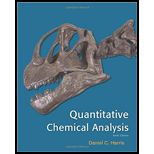
(a)
Interpretation:
Concentration of
Concept introduction:
Parts Per Million refers to a term that expresses concentration of certain substance in a mixture of substances. It is denoted as ppm. It is represented as,
In solution concentrations,
Molarity is a concentration term that is used to express the concentration of the solute in solution. It is represented as,
(a)
Answer to Problem 1.CE
Concentration of
Explanation of Solution
Each mol of
Given that the solution made of
(b)
Interpretation:
The number of ppm of
Concept introduction:
Parts Per Million refers to a term that expresses concentration of certain substance in a mixture of substances. It is denoted as ppm. It is represented as,
In solution concentrations,
Molarity is a concentration term that is used to express the concentration of the solute in solution. It is represented as,
(b)
Answer to Problem 1.CE
The number of ppm of
Explanation of Solution
Given that concentration of
As we know,
No. of moles of the solute
Therefore molarity of
Formula weight of
Let the volume of solution be
No. of moles of
As we know,
(c)
Interpretation:
The number of ppm of
Concept introduction:
Parts Per Million refers to a term that expresses concentration of certain substance in a mixture of substances. It is denoted as ppm. It is represented as,
In solution concentrations,
Molarity is a concentration term that is used to express the concentration of the solute in solution. It is represented as,
(c)
Answer to Problem 1.CE
The number of ppm of
Explanation of Solution
Given that concentration of
Want to see more full solutions like this?
Chapter 1 Solutions
Quantitative Chemical Analysis 9e & Sapling E-Book and Homework for Quantitative Chemical Analysis (Six Month Access) 9e
 ChemistryChemistryISBN:9781305957404Author:Steven S. Zumdahl, Susan A. Zumdahl, Donald J. DeCostePublisher:Cengage Learning
ChemistryChemistryISBN:9781305957404Author:Steven S. Zumdahl, Susan A. Zumdahl, Donald J. DeCostePublisher:Cengage Learning ChemistryChemistryISBN:9781259911156Author:Raymond Chang Dr., Jason Overby ProfessorPublisher:McGraw-Hill Education
ChemistryChemistryISBN:9781259911156Author:Raymond Chang Dr., Jason Overby ProfessorPublisher:McGraw-Hill Education Principles of Instrumental AnalysisChemistryISBN:9781305577213Author:Douglas A. Skoog, F. James Holler, Stanley R. CrouchPublisher:Cengage Learning
Principles of Instrumental AnalysisChemistryISBN:9781305577213Author:Douglas A. Skoog, F. James Holler, Stanley R. CrouchPublisher:Cengage Learning Organic ChemistryChemistryISBN:9780078021558Author:Janice Gorzynski Smith Dr.Publisher:McGraw-Hill Education
Organic ChemistryChemistryISBN:9780078021558Author:Janice Gorzynski Smith Dr.Publisher:McGraw-Hill Education Chemistry: Principles and ReactionsChemistryISBN:9781305079373Author:William L. Masterton, Cecile N. HurleyPublisher:Cengage Learning
Chemistry: Principles and ReactionsChemistryISBN:9781305079373Author:William L. Masterton, Cecile N. HurleyPublisher:Cengage Learning Elementary Principles of Chemical Processes, Bind...ChemistryISBN:9781118431221Author:Richard M. Felder, Ronald W. Rousseau, Lisa G. BullardPublisher:WILEY
Elementary Principles of Chemical Processes, Bind...ChemistryISBN:9781118431221Author:Richard M. Felder, Ronald W. Rousseau, Lisa G. BullardPublisher:WILEY





